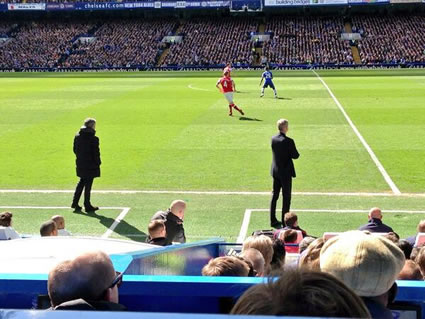By Michael Shanks
Team strategy has often been appropriately called “style of play”. Many countries around the world adhere to one style of play. For example, the Italians are notoriously known for scoring one goal, then playing defensively the rest of the game in order to win 1-0. According to expertfootball.com, Italian teams are very cautious about the number of players they are committing forward.
Credit to German Football for the team picture above.
Soccer players use a variety of skills and rapid tempo changes in the buildup process. They make forward runs at all angles which is unpredictable and difficult to contain. Defenders prefer to slow the tempo down, shield and play the ball back. They like to saturate their own half and shut down their opposition. Often times this style is unappreciated by fans that get bored, because they have trouble valuing the subtle beauty in playing good possession soccer.
For club soccer, the most famous soccer style of play is the Barcelona way. Tiki Taka football. Many clubs and countries have taken bits and pieces of the possession game and incorporated it into their playing style. What’s more, with keepers now often starting the attack out of the back, possession soccer is something that’s just part of the game now.
Actually, in Europe its more whistling you hear from fans when their team doesn’t have possession of the ball. Or, you might even hear whistling from fans when a team is playing too conservatively or boring football. Fans want teams to challenge other teams and put them on the back foot.

Soccer playing style: Each country has their way of playing. Increasingly, teams are pressing more up the field and now goalkeepers are also part of the possession game and have to have solid skills with the ball at their feet.
Two of the world’s most well known countries in soccer play with highly contrasting styles.
First, the Germans are known for their efficient and forceful game plan. The players on the German team are in general very fast, organized, and aggressive. Their attacks, while hard to defend because of incredible intensity, are somewhat predictable. In the defense, a general shape of a back line “U” is maintained.
German players are expected to play their designated role on the team in order to maintain the overall machine, and never to overly improvise upon the system. The team is known as a powerhouse of Northern Europe, for good reason. The German “machine” only has two settings while in possession: a hammering attack or keeping possession with the back line and midfield. There is no in between.
This emphasis on precision and efficiency reflects those characteristics which are paramount in German culture. As they say, “The trains run on time in Germany”. One can look at the engineering prowess of the automobile industry in Germany and identify the same characteristics of speed, efficiency and power.
Contrasting the German style, Brazil has produced national teams that consistently serve as a supreme example of Latin-style play. The players are generally very confident with the ball, excellent dribblers, and are highly creative. They place huge emphasis on possessing the ball. Attacks are not built off of practiced, premeditated plays, but rather arise out of spontaneity. Likewise, the ball is moved spontaneously, with many individual-based plays. The style is largely improvisational and free-flowing.
Generally speaking, Latin countries place a large emphasis on individuality. As a testament to the importance of individuality, these countries are not generally known to produce large corporations or organizations. This doesn’t have to do with less of an ability to do so, but rather the fact that the cultural atmosphere is such that individuality is attractive and can flourish. Latinos are known as some of the most passionate people in the world.
For example, one of the most famous pieces of Latin literature is Cervantes’ Don Quixote, centered on a romantic, impractical, yet passionate idealist. This passion fuels a mentality of creativity and improvisation. These characteristics are manifested in traditional Latin literature, dance, and music. In Brazil, the leading cultural spectacle is the annual carnival pre-lental celebration, which features an explosion of passion, color, drama, and outlandish, creative costumes, all to the pervasive samba beat.
Why do we care about national styles of play in soccer? Because we can learn crucial characteristics about a culture simply by watching them play a game on a field with a round ball. And of course, based on the culture you can usually tell what style of soccer they’re going to play.
A big disruption in the soccer / football style of play happened at the World Cup in 2014 in Germany. Where, to the surprise of the whole world, Germany out style Brazil and beat them 7-1 in the semi-finals.
Soccer playing style isn’t a fixed thing either. Countries do change their style of play in subtle ways over the years.
Read more on the pages below:















